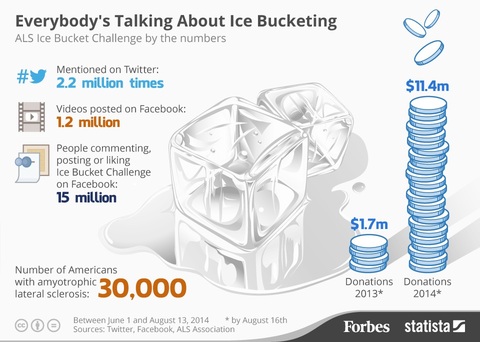|
Over the last few weeks we’ve seen videos of people screaming while getting soaked in the ice bucket challenge. From celebrities showering themselves in ice, to friends, family and strangers joining the trend.
People wanted to get their own version out there, nominating each other and spreading the word and raising funds for charities. it’s been a challenge that social media users couldn’t get enough of. As this stunt proved to be popular with all age groups, demographics around the world, it managed to raise awareness about Amyotrophic Lateral Sclerosis (ALS), a progressive disease of the nervous system, and significant donations flowed from far and wide. But how effective are such fads, from a longterm perspective? Making new behaviour ‘stick’ takes effort that allows the change to become part of the everyday norm, and sometimes, gimmicks like the ice bucket challenge can act as a catalyst for behaviour change, however showering in ice alone may not deliver the needs of charities for the longterm, while others argue that such campaigns may do more harm than good. The Giuardian ran an interesting article on the subject, you can click here to read more about it. Or for an interesting insight from an economist’s point of view, you can click here to see what they make of the challenge. In any case, it is vital to ensure that a viral campaign raises awareness about the disease, while also going beyond the one off donation into an ongoing commitment that converts this highly successful viral campaign into one that engenders positive, long-term behavioural change. Finally, I am pleased to share with you some great tips and ideas from Forbes on how other charities could benefit, a personal favourite is the ‘no-selfie challenge', click here to read the article.
2 Comments
Dave allen
7/4/2024 03:21:40 pm
Investment is one of the best ways to achieve financial freedom. For a beginner there are so many challenges you face. It's hard to know how to get started. Trading on the Cryptocurrency market has really been a life changer for me. I almost gave up on crypto at some point not until saw a recommendation on Elon musk successfully success story and I got a proficient trader/broker Mr Bernie Doran , he gave me all the information required to succeed in trading. I made more profit than I could ever imagine. I'm not here to converse much but to share my testimony; I have made total returns of $20,500.00 from an investment of just $2000.00 within 1 week. Thanks to Mr Bernie I'm really grateful,I have been able to make a great returns trading with his signals and strategies .I urge anyone interested in INVESTMENT to take bold step in investing in the Cryptocurrency Market, he can also help you recover your lost funds, you can reach him on WhatsApp : +1(424) 285-0682 or his Gmail : [email protected] tell him I referred you
Reply
Leave a Reply. |
Categories
All
AuthorSandra Anani is passionate about sustainability, with over 19 years’ experience. She has dedicated her career to sustainable development and communications. Archives
November 2022
|


 RSS Feed
RSS Feed
